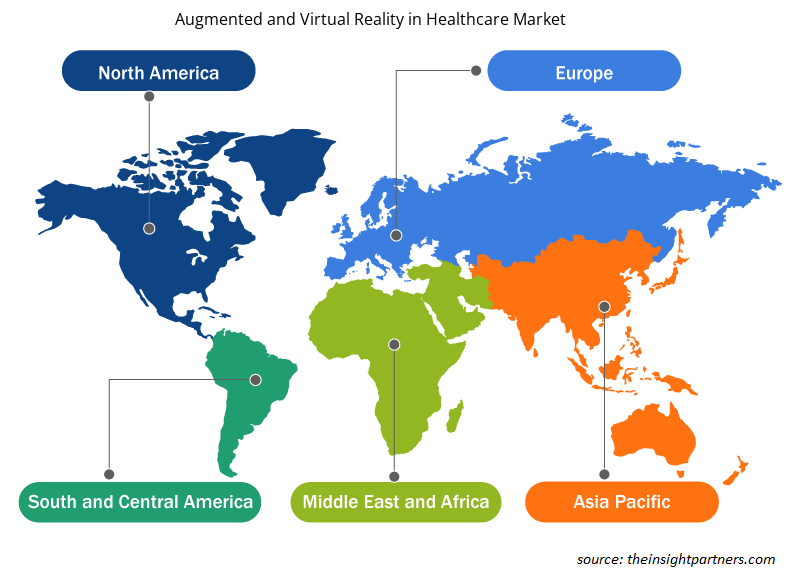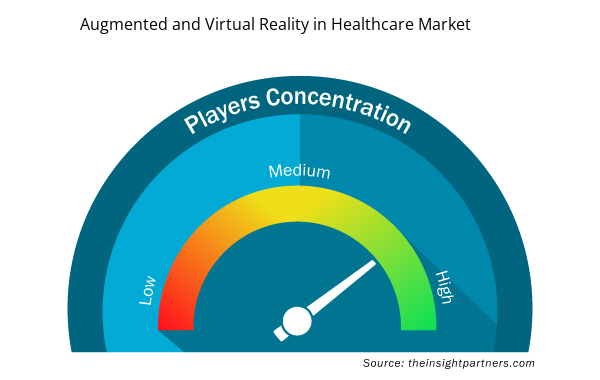The Augmented and Virtual Reality in Healthcare Market is expected to register a CAGR of 35.2% from 2025 to 2031, with a market size expanding from US$ XX million in 2024 to US$ XX Million by 2031.
The report is segmented by Component (Hardware, Software, Services), Technology (Augmented Reality, Virtual Reality), Application (Patient Care Management, Fitness Management, Surgery Medical Training and Education, and Others), End User (Hospitals and Clinics, Surgical Centers, Research Organizations and Pharma Companies, Research and Diagnostics Laboratories, and Others). The global analysis is further broken-down at regional level and major countries. The report offers the value in USD for the above analysis and segments
Purpose of the Report
The report Augmented and Virtual Reality in Healthcare Market by The Insight Partners aims to describe the present landscape and future growth, top driving factors, challenges, and opportunities. This will provide insights to various business stakeholders, such as:
- Technology Providers/Manufacturers: To understand the evolving market dynamics and know the potential growth opportunities, enabling them to make informed strategic decisions.
- Investors: To conduct a comprehensive trend analysis regarding the market growth rate, market financial projections, and opportunities that exist across the value chain.
- Regulatory bodies: To regulate policies and police activities in the market with the aim of minimizing abuse, preserving investor trust and confidence, and upholding the integrity and stability of the market.
Augmented and Virtual Reality in Healthcare Market Segmentation
Component
- Hardware
- Software
- Services
Technology
- Augmented Reality
- Virtual Reality
Application
- Patient Care Management
- Fitness Management
- Surgery Medical Training and Education
- Others
End User
- Hospitals and Clinics
- Surgical Centers
- Research Organizations and Pharma Companies
- Research and Diagnostics Laboratories
- Others
Customize This Report To Suit Your Requirement
You will get customization on any report - free of charge - including parts of this report, or country-level analysis, Excel Data pack, as well as avail great offers and discounts for start-ups & universities
Augmented and Virtual Reality in Healthcare Market: Strategic Insights

- Get Top Key Market Trends of this report.This FREE sample will include data analysis, ranging from market trends to estimates and forecasts.
Augmented and Virtual Reality in Healthcare Market Growth Drivers
- Improved Medical Training and Education: Augmented and virtual reality technologies are revolutionizing medical education by offering immersive training environments for healthcare professionals. VR simulations allow medical students and professionals to practice surgeries, diagnose conditions, and understand human anatomy in a safe, controlled setting. AR is used in medical simulations to overlay digital images of anatomy onto a patient's body, helping students learn in real-world scenarios. These immersive learning tools are significantly enhancing the efficiency and quality of medical training, driving the market for AR and VR in healthcare.
- Enhanced Patient Treatment and Therapy: VR and AR are becoming integral in patient rehabilitation and therapy. VR is used in pain management, where patients can immerse themselves in calming virtual environments to distract from pain during treatments. AR is applied in physical rehabilitation to guide patients through exercises by overlaying instructions or feedback in real-time. These therapies are showing promise in improving patient outcomes, especially in conditions such as PTSD, anxiety disorders, stroke recovery, and chronic pain management. The effectiveness of these therapies is a key driver for the market.
Augmented and Virtual Reality in Healthcare Market Future Trends
- Robotic-assisted surgery: The latest innovation in the healthcare sector that fosters the use of AR and VR technologies is robotic-assisted surgeries. The use of robots for surgeries in numerous specialties, including gastrointestinal, gynecologic oncology, cardiothoracic, and otolaryngology (head and neck), among others, is the trend of the market. The use of AR via robotics technology enhances the surgeon's perception and decision-making during procedures, ultimately leading to advanced patient outcomes.
- Increased Use in Mental Health Treatment: VR is increasingly being used for mental health treatments, especially for conditions like anxiety, depression, post-traumatic stress disorder (PTSD), and phobias. VR therapy enables patients to immerse themselves in controlled virtual environments where they can confront their fears or practice relaxation techniques. Additionally, AR has shown potential in enhancing cognitive behavioral therapy by providing interactive feedback. As awareness of mental health continues to grow, VR and AR applications in mental health treatment are expected to gain significant traction.
Augmented and Virtual Reality in Healthcare Market Opportunities
- Technological Innovations in the emerging economies: With the extended use of connected technologies in the healthcare sector, the demand for advanced technologies such as AR and VR technologies is expected to rise in emerging economies, such as India and China, in the coming years. The focus on personalized patient experiences and increasing outreach to remote places will foster the demand for AR and VR technologies.
- Government Focus to integrate AR and VR technologies : According to the India Brand Equity Foundation, the AR and VR market is expected to grow at a significant rate in upcoming years in India. Investment and initiatives to integrate AR and VR technologies in the healthcare sector will create lucrative opportunities for market growth.
Augmented and Virtual Reality in Healthcare Market Regional Insights
The regional trends and factors influencing the Augmented and Virtual Reality in Healthcare Market throughout the forecast period have been thoroughly explained by the analysts at Insight Partners. This section also discusses Augmented and Virtual Reality in Healthcare Market segments and geography across North America, Europe, Asia Pacific, Middle East and Africa, and South and Central America.

- Get the Regional Specific Data for Augmented and Virtual Reality in Healthcare Market
Augmented and Virtual Reality in Healthcare Market Report Scope
| Report Attribute | Details |
|---|---|
| Market size in 2024 | US$ XX million |
| Market Size by 2031 | US$ XX Million |
| Global CAGR (2025 - 2031) | 35.2% |
| Historical Data | 2021-2023 |
| Forecast period | 2025-2031 |
| Segments Covered |
By Component
|
| Regions and Countries Covered | North America
|
| Market leaders and key company profiles |
Augmented and Virtual Reality in Healthcare Market Players Density: Understanding Its Impact on Business Dynamics
The Augmented and Virtual Reality in Healthcare Market market is growing rapidly, driven by increasing end-user demand due to factors such as evolving consumer preferences, technological advancements, and greater awareness of the product's benefits. As demand rises, businesses are expanding their offerings, innovating to meet consumer needs, and capitalizing on emerging trends, which further fuels market growth.
Market players density refers to the distribution of firms or companies operating within a particular market or industry. It indicates how many competitors (market players) are present in a given market space relative to its size or total market value.
Major Companies operating in the Augmented and Virtual Reality in Healthcare Market are:
- General Electric Company
- EON Reality Inc.
- LAYAR
- Hologic, Inc.
Disclaimer: The companies listed above are not ranked in any particular order.

- Get the Augmented and Virtual Reality in Healthcare Market top key players overview
Key Selling Points
- Comprehensive Coverage: The report comprehensively covers the analysis of products, services, types, and end users of the Augmented and Virtual Reality in Healthcare Market, providing a holistic landscape.
- Expert Analysis: The report is compiled based on the in-depth understanding of industry experts and analysts.
- Up-to-date Information: The report assures business relevance due to its coverage of recent information and data trends.
- Customization Options: This report can be customized to cater to specific client requirements and suit the business strategies aptly.
The research report on the Augmented and Virtual Reality in Healthcare Market can, therefore, help spearhead the trail of decoding and understanding the industry scenario and growth prospects. Although there can be a few valid concerns, the overall benefits of this report tend to outweigh the disadvantages.
- Historical Analysis (2 Years), Base Year, Forecast (7 Years) with CAGR
- PEST and SWOT Analysis
- Market Size Value / Volume - Global, Regional, Country
- Industry and Competitive Landscape
- Excel Dataset


- Pressure Vessel Composite Materials Market
- Nitrogenous Fertilizer Market
- Single Pair Ethernet Market
- Retinal Imaging Devices Market
- Vision Care Market
- Helicopters Market
- Excimer & Femtosecond Ophthalmic Lasers Market
- Online Recruitment Market
- Trade Promotion Management Software Market
- Precast Concrete Market

Report Coverage
Revenue forecast, Company Analysis, Industry landscape, Growth factors, and Trends

Segment Covered
This text is related
to segments covered.

Regional Scope
North America, Europe, Asia Pacific, Middle East & Africa, South & Central America

Country Scope
This text is related
to country scope.
Frequently Asked Questions
Some of the customization options available based on the request are an additional 3-5 company profiles and country-specific analysis of 3-5 countries of your choice. Customizations are to be requested/discussed before making final order confirmation# as our team would review the same and check the feasibility
The report can be delivered in PDF/PPT format; we can also share excel dataset based on the request
Robotic-assisted surgery are likely to remain a key trend in the market.
Digitalization in the healthcare industry and benefits of AR and VR technology in the healthcare sector are the major factors driving the augmented and virtual reality in healthcare market.
The Augmented and Virtual Reality in Healthcare Market is estimated to witness a CAGR of 35.2% from 2023 to 2031
Trends and growth analysis reports related to Technology, Media and Telecommunications : READ MORE..
The List of Companies
1. Google
2. General Electric Company
3. EON Reality Inc.
4. LAYAR
5. Hologic, Inc.
6. Koninklijke Philips N.V.
7. Siemens Medical Solutions USA, Inc.
8. CAE HEALTHCARE
9. Intuitive Surgical
10. TheraSim Inc.
11. Microsoft
12. DAQRI
13. Psious
14. Mindmaze
15. Firsthand Technology
16. Medical Realities
17. Atheer
18. Augmedix
19. Oculus VR
20. 3D Systems
21. VirtaMed
22. HTC
23. Virtually Better
24. WORLDVIZ

 Get Free Sample For
Get Free Sample For